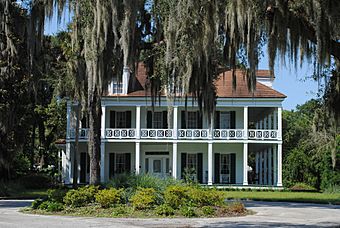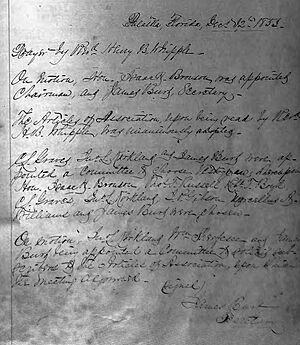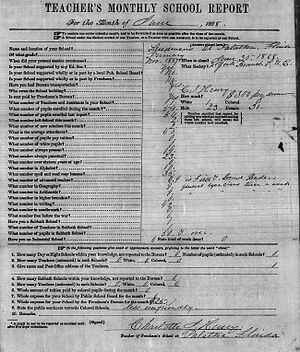Bronson–Mulholland House facts for kids
Quick facts for kids |
|
|
Bronson–Mulholland House
Judge Isaac Bronson House |
|
 |
|
| Location | 100 Madison Street Palatka, Florida |
|---|---|
| Built | 1854 |
| Architectural style | Southern Colonial |
| NRHP reference No. | 72000351 |
| Added to NRHP | 27 December 1972 |
The Bronson–Mulholland House is a very old and important house located at 100 Madison Street in Palatka, Florida. It's also known by other names like Sunny Point or the Judge Isaac H. Bronson House. This historic home was built way back in 1854. Because of its history, it was added to the U.S. National Register of Historic Places on December 27, 1972.
Contents
History of the Bronson–Mulholland House
The Bronson Family: 1852–1860
Judge Isaac H. Bronson first thought about moving to Palatka, Florida, around 1852. He received a large piece of land, about 1,220 acres, from three important Palatka families. In 1855, Isaac and his wife, Sophronia, returned most of this land. They kept a special part for themselves, which they called Sunny Point.
The Bronsons decided to make Palatka their home in 1853. They set aside 10 acres of land along the St. Johns River for their estate, Sunny Point. Records show that Judge Bronson was building his home and farming the land by March 1854. By October 1854, Sunny Point was officially set aside for their home. It is likely the Bronsons spent their first winter in their new house in 1854.
It is thought that Judge Bronson used cypress wood from nearby the Ocklawaha River to build his home. He was also part owner of the Palatka Saw Mill Company. This mill had a steam saw by August 1853. The wood for the large 7,199 square foot Bronson home was probably cut at this very saw mill.
The Bronsons and Palatka Town
The Bronson family played a big part in helping Palatka grow. Judge Bronson helped create the city's official rules and laws. He also asked for the town to become the main city for Putnam County, Florida. He even gave the land for the county courthouse, which is still there today.
The Bronsons and their two daughters, Gertrude and Emma, were members of St. Mark's Episcopal Church (Palatka, Florida). Judge Bronson was a leader and one of the first members of the church board.
The Bronsons often had important guests at their new home. These visitors included William Dunn Moseley, Florida's first state governor. Other guests were Robert Raymond Reid, another Florida governor, and Benjamin A. Putnam. Putnam County was named after Benjamin Putnam. People in the 1850s saw Sunny Point as a lively social spot.
Judge Isaac Bronson passed away on August 13, 1855. He was buried on his property at Sunny Point. His tombstone said he was a good friend, a fair citizen, and a humble church member. When Sophronia Bronson sold the property in 1867, the new owner promised to protect his burial spot. Later, in 1892, Isaac's daughters agreed to move his grave. Today, Judge Isaac Bronson's tomb is in Palatka's Oak Hill Cemetery.
Before he passed away, Isaac Bronson made George A. Fairbanks a trustee for Sophronia Bronson. This was likely to protect Sophronia financially after her husband's death. Sophronia Bronson stayed at Sunny Point after Isaac passed away. Records show she was in Palatka in November 1856. She likely stayed at Sunny Point until the Civil War began in 1860. She then probably went back to her home state of New York. Sophronia Bronson passed away in Morristown, New Jersey, in June 1874.
The Civil War Years: 1861–1865
Sunny Point was empty during the American Civil War. It is believed that early in the war, Confederate soldiers used the house's attic. They used it as a lookout point for Union forces coming down the St. John's River. In 1864, Union troops took over Palatka. They used Sunny Point as a camp. The house also served as a lookout for Union soldiers watching for Confederate ships trying to sneak past their blockades.
The White Family Era: 1866–1904
Charlotte Henry and the School
Charlotte Henry (who later became Charlotte White) was from New York. She became good friends with Sophronia Bronson after Sophronia returned to New York. It is not known how they met, but they both believed in ending slavery. This friendship led Charlotte Henry to come to Palatka. In October 1865, Miss Henry bought 300 acres of land near Palatka. In January 1866, she opened a school in Palatka. This school was supported by a group called the New York branch of the Freedmen's Bureau.
While it's not clear where the first classes were held, later information shows that Miss Henry's school always met at Sunny Point. Sunny Point was rented by Sophronia Bronson to the Freedman's Union Commission in November 1866. At that time, Charlotte Henry was teaching over 60 African American children. She seemed to enjoy her work and decided to buy the property from Mrs. Bronson. Miss Henry paid $6,000 and agreed to continue the lease with the Freedman's Union Commission.
Charlotte Henry continued her school in Palatka until June 1868. She also likely handed out supplies sent by the government to the students every Saturday. Sadly, the school closed in 1868. However, Miss Henry stayed in Palatka, showing she got along well with the townspeople. The school likely closed because of money problems. The Freedman's Union Commission, which supported the school, was starting to close down. It completely stopped its work by the next year.
Charlotte and Nathaniel P. White
In March 1873, Nathaniel P. White took over Miss Henry's loan on her other property. They were probably married by this time, likely in New York. The first record of Charlotte Henry as Mrs. Nathaniel P. White was in 1874. They were listed as members of St. Mark's Episcopal Church. Nathaniel White was from Michigan. It is thought he met Miss Henry while on vacation in Palatka.
Church records show the White family gave money to St. Mark's church mostly in the winter. A newspaper article from September 1875 said that "Bronson's point is looking grand and beautiful, but it needs its occupants N.P. White, Esq., and his excellent wife to charm it into life." Another newspaper in June 1892 noted that N.P. White was leaving for Pennsylvania. He had spent the previous two summers in New Hampshire and Michigan. This suggests that Sunny Point became a summer home for the Whites.
Nathaniel White passed away in Michigan in December 1895. Charlotte became the owner of all his property in Michigan and Florida. It is not known exactly how Mrs. White spent her time after her husband's death. However, she likely spent much of it at Sunny Point. In 1899, her name appeared as a member of St. Mark's Church. She passed away in Palatka in January 1904 at 82 years old. She is buried in Oak Hill Cemetery in Palatka, the same cemetery as Judge Isaac Bronson.
The Mulholland Family: 1904–1945
Mary Mulholland was born in 1842. She trained as a nurse in Boston, Massachusetts. She continued her studies and almost became a medical doctor. She met Charlotte White in Boston, but the exact year is unknown.
Mary Mulholland likely came to Sunny Point for vacations with the Whites. She then stayed to help care for Nathaniel White when he became sick. After his death in 1895, she continued to live with Charlotte at Sunny Point.
In January 1904, just before she passed away, Charlotte White gave Sunny Point to Mary Mulholland. The property was almost the same size as when Sophronia Bronson sold it in 1867. However, Miss Mulholland could not keep all the land. In 1914, she started selling parts of it for homes. By 1936, at least seven other houses stood on what was once Sunny Point. Miss Mulholland also borrowed over $7,500 between 1917 and 1935. This money was used to pay property taxes. She worked hard to keep the place beautiful. She put up stone posts at the entrances with "Mulholland Park" carved into them. The land was beautifully gardened with weeping willows and oleanders along the river.
Mary Mulholland did not work as a nurse after Mrs. White passed away. She was in her sixties by then. She would quietly help the poor with her medical knowledge and never refused a call for help. After World War I began, Miss Mulholland became active in the Putnam County Red Cross Chapter. She was a Vice Chairman in 1917 when the chapter first started. She let the Red Cross use the east side of her home as a work room. She also visited soldiers' homes to help them.
Mary Mulholland passed away in Palatka on October 4, 1935. She is buried in Oak Hill Cemetery, along with Judge Isaac Bronson and Charlotte White. When she passed away, Sunny Point went to Edelmira Rivero. Mary Mulholland wrote that Edelmira had lived with her since she was a little girl. She said Edelmira had been a great help and kind to her.
Edelmira Rivero and Sunny Point
Edelmira Rivero was born in Cuba during the Spanish–American War. Her parents passed away when she was very young. She and her older sister, Taurina, became orphans. They eventually ended up in a Florida orphanage. They stayed there until Edelmira was ten or eleven. Taurina described her sister as a beautiful young girl. Edelmira was often shown around as an example of the children the orphanage cared for. However, Taurina said the orphanage was not a nice place to live, and they eventually ran away. It is not known how they came to Palatka. Soon after, Mary Mulholland hired Taurina as a housekeeper. Miss Mulholland became very fond of Edelmira and wanted to adopt her. However, Taurina would not allow it.
When Taurina married in 1907, she told Edelmira she could either live with her or stay with Miss Mulholland. Miss Mulholland promised Taurina that Edelmira would be well cared for and get a college education if she stayed. Edelmira chose to stay, and Miss Mulholland kept her promise. Throughout her life, Taurina often visited them at Sunny Point.
When Miss Mulholland passed away in 1935, Miss Rivero had become a teacher in Jacksonville, Florida. She could not live in Palatka. She had the shutters of Sunny Point closed and locked. She eventually moved the furniture, much of which was from when the Whites lived there, to Jacksonville. At the same time, she allowed the Red Cross Chapter to continue meeting in the house. The chapter met in the west side of the house. They continued their service activities through World War II.
Edelmira Rivero owned the house for ten years. Like Miss Mulholland, she had to sell parts of Sunny Point as building lots. In 1945, Edelmira felt she could no longer keep Sunny Point. Later in her life, she wrote:
I loved the beautiful house in which I had grown up, and wanted to keep it. I held on for ten years. During World War II I let the Red Cross make their headquarters there. The roof leaked, I had a new roof put on and it still leaked. I was teaching in high school in Jacksonville and couldn't be in Palatka. I had seen how Miss Mulholland had struggled through the years to hold the property. Doing without things herself and borrowing to pay the high taxes. I realized I couldn't afford to hold on to it, so I sold it.
The land Edelmira Rivero sold in 1945 is the same size as the property today. She continued to live and teach in Jacksonville until she passed away in 1974. She was buried next to Mary Mulholland in Oak Hill Cemetery, along with other past residents of Sunny Point.
After the War: 1945–1977
In 1945, Sunny Point (then called Mulholland Park) was briefly owned by Reverend and Mrs. J.C. Yelton. They sold the house in 1946 to Laura and E.C. Hindman. The Hindmans likely divided the house into apartments. They also enclosed the east porches soon after buying it. A newspaper article in November 1946 mentioned that "Mr. and Mrs. B.M. Jones have moved to the Hindman Apartments in Mulholland Park."
In 1955, the Hindmans sold the house to their daughter and son-in-law, Grace and James Jones. The city guide in 1956 listed nine apartments at the house's address. People who lived there in the 1950s said it had between 8 and 14 apartments. In May 1956, it was sold again to Key David McMurrain. He promised to keep the property in good repair and insured. In 1962, the house was given to McMurrain's ward, William. The house was called the Mulholland Apartments in 1960 and 1964 guides.
Finally, in January 1965, William McMurrain sold the property to the City of Palatka. This ended the time when the house was used as apartments. At this point, the house was in very bad shape. People then became interested in making the house beautiful again. The Bronson–Mulholland house was added to the National Register of Historic Places in 1972. It opened to visitors in 1977.
Restoring the House: 1977–Present
Many efforts have been made over the years to carefully restore the Bronson–Mulholland house. The City of Palatka owns the building and the land around it. The Putnam County Historical Society helps take care of all the furniture inside. Because of the house's long history, very few of its original furnishings remain. Most of the pieces are old antiques from the mid to late 1800s. Many were kindly given or loaned by local families. However, some pieces loaned by Edelmira Rivero's family are original to the home. These pieces were there when the White family lived in the house.
Today, the house is both a historical place and a venue for events. Every year in late September, people dressed as Civil War soldiers gather outside the house. They act out the Union Army taking over Palatka in 1864. Recently, efforts have been made to make the home a popular place for weddings again in Northeast Florida.
Future Plans for the House
The City of Palatka hopes to make the house more popular. They want to promote it as a place for weddings and events. They also want it to be an important cultural and historical resource for people in Florida. A monthly newsletter and a Facebook page have been started. There is also an active website. The home is often open for tours. Regular history talks are held for the public in the front room.
Currently, the home is being renovated. Most of the work is on the first floor porch. This porch was removed because the wood was damaged and worn. The home is currently surrounded by a construction fence. However, the home and the museum next door are still open to the public regularly. There is no official date for when the restoration work will be finished.
Gallery
See also













